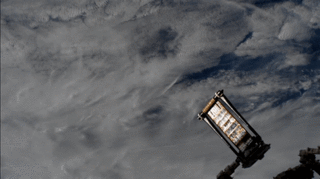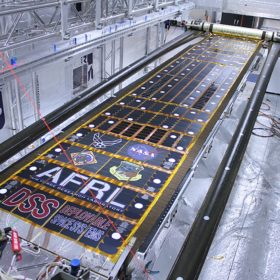Satellites usually rely on bulky solar arrays, folded with hinges similar to the rigid ones that are used to empower homes and businesses. NASA, therefore, has been looking for a smaller and lighter version than the traditional panels to make the next step to the future of spaceflight and upcoming missions.
The space agency has now reported a successful test deployment of its Roll Out Solar Array (ROSA) technology. Over the past weekend, ground controllers remotely rolled out the solar array, where it will remain attached on a robotic arm for the next seven days. In the meantime the panels will undergo a series of operational tests to examine how the system responds to microgravity, vibrations or extreme temperatures.

“When the array is attached to a satellite, that spacecraft will need to maneuver, which creates torque and causes the wing, or blanket, to vibrate,” explained principal investigator Jeremy Banik, senior research engineer at the Air Force Research Laboratory, Kirtland Air Force Base in New Mexico. “We need to know precisely when and how it vibrates so as not to lose control of the spacecraft. The only way to test that is in space.”
According to NASA, those new panels are incredibly lightweight and flexible, which makes them easily packed into a rocket for launch. In addition, the technology have the potential to be easily adapted to different sizes and used to empower satellites for different purposes as television, GPS or weather forecasting.
Popular content

Source: Deployable Space Systems
“This new solar array's design rolls up to form a compact cylinder for launch with significantly less mass and volume, potentially offering substantial cost savings as well as an increase in power for satellites,” says NASA.
On Tuesday NASA released a video showing the solar array´s deployment from the space station arm. Before it could do so, ROSA underwent several test inside vacuum chambers on earth a few years ago.
NASA hopes that after more successful testing, the roll out technology could not only replace standard solar panels on other satellites but also appear on highly maneuverable spacecraft in the long term.
This content is protected by copyright and may not be reused. If you want to cooperate with us and would like to reuse some of our content, please contact: editors@pv-magazine.com.


By submitting this form you agree to pv magazine using your data for the purposes of publishing your comment.
Your personal data will only be disclosed or otherwise transmitted to third parties for the purposes of spam filtering or if this is necessary for technical maintenance of the website. Any other transfer to third parties will not take place unless this is justified on the basis of applicable data protection regulations or if pv magazine is legally obliged to do so.
You may revoke this consent at any time with effect for the future, in which case your personal data will be deleted immediately. Otherwise, your data will be deleted if pv magazine has processed your request or the purpose of data storage is fulfilled.
Further information on data privacy can be found in our Data Protection Policy.